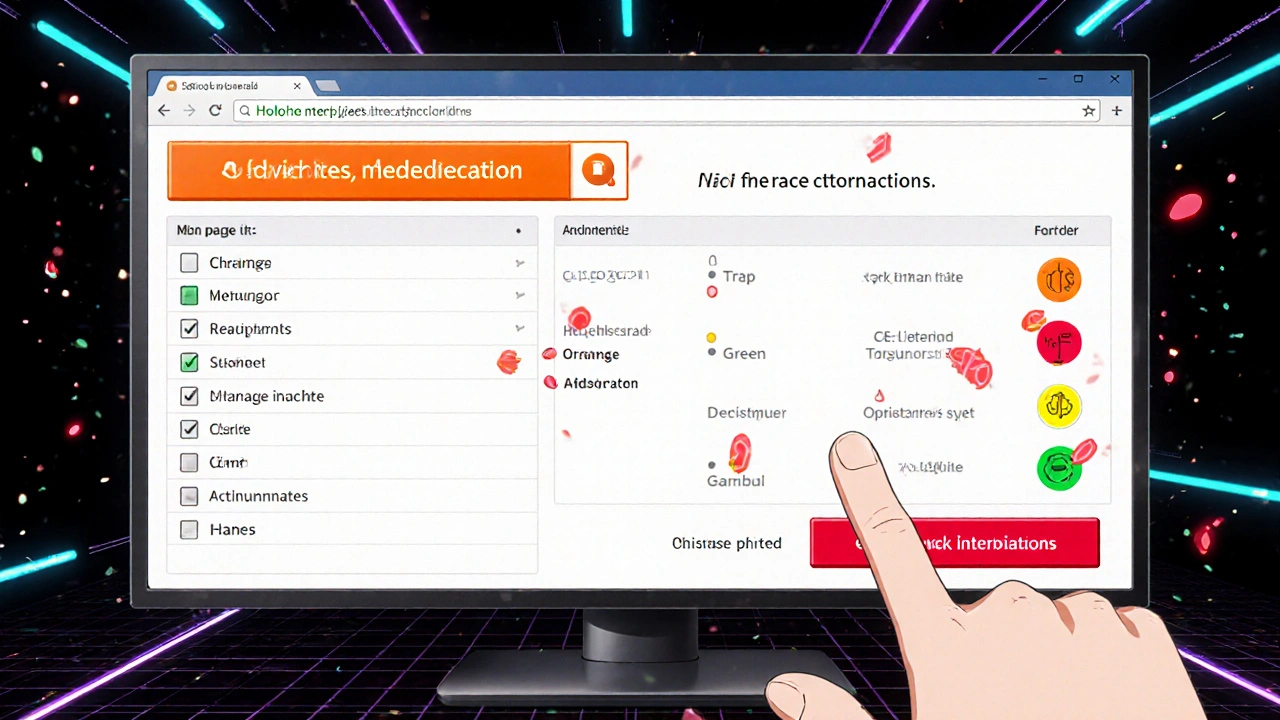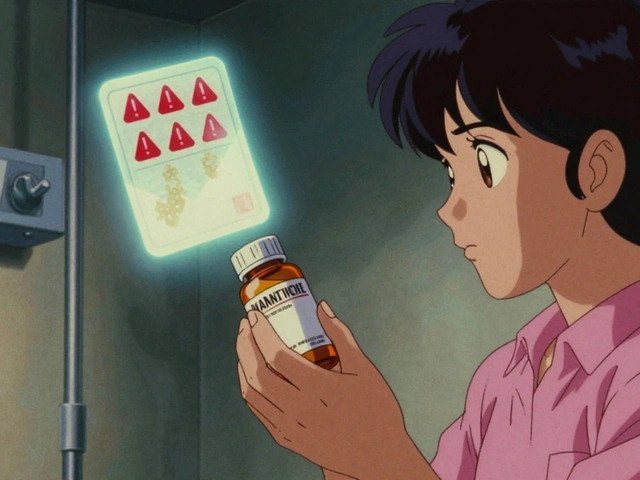Drug Interaction Simulator
How This Simulator Works
This tool simulates the results you'd see from a real drug interaction checker. Enter medications and see how the system identifies potential interactions using the color-coded severity scale.
Interaction Result
Enter two medications to see interaction results
Interpretation Guide
- Red – Contraindicated (do not combine)
- Orange – Major interaction; monitor or adjust dose
- Yellow – Moderate; clinical relevance may vary
- Green – No known interaction
Always consult a healthcare professional when you see any warning. This simulation is for educational purposes only.
Ever wondered if the pills you take together could clash? A drug interaction checker can spot risky combos before they cause trouble. This guide walks you through why the tool matters, how to pick the right one, and exactly what to click from start to finish.
What is a Drug Interaction Checker?
Drug Interaction Checker is a software utility that scans the pharmacological properties of two or more substances and flags potential adverse interactions. It pulls data from curated databases, evaluates severity levels, and delivers a summary that clinicians and patients can act on.
Why use a drug interaction checker?
In the United States, nearly half of adults take at least one prescription medication, and many manage multiple drugs daily. The Agency for Healthcare Research and Quality (AHRQ) estimates that preventable adverse drug events cost the healthcare system over $2 billion each year. Clinical decision‑support systems, powered by drug interaction checkers, are credited with averting roughly 1.5 million harmful events annually.
Beyond cost savings, the tools improve confidence. A 2022 JAMA Internal Medicine review noted that while checkers have a 60‑85 % sensitivity rate, combining two programs plus a pharmacist review boosts safety considerably.
Choosing the right checker
Not all checkers are built alike. Below is a snapshot of the most‑used options as of 2025. Consider cost, platform, and reported accuracy when deciding.
| Checker | Platform | Typical cost | Accuracy (NIH 2016 study) | Key pros | Key cons |
|---|---|---|---|---|---|
| Lexi‑Interact | EHR integration, web | $1,200‑$2,500 / yr | 62.5 % | Highest combined accuracy, extensive monographs | Training required (2‑3 hrs) |
| Micromedex | Enterprise EHR, desktop | $1,500‑$3,000 / yr | 59 % | Deep database, hospital‑grade support | Frequent false positives reported by clinicians |
| Medisafe (iOS/Android) | Mobile app | Free‑basic, $4.99 / mo premium | 55 % | Consumer‑friendly UI, reminders | Limited to US market (iOS as of 2018, now global) |
| Epocrates | Mobile & web | Free basic, $9.99 / mo premium | 57 % | Fast lookup, good for clinicians on the go | Accuracy lower than Lexi‑Interact |
| DrugBank API | Developer API | Subscription $199 / mo | 57 % | Integration flexibility, includes supplements | Requires technical skill to implement |
| University of Liverpool COVID‑19 DDI Checker | Web (specialty) | Free | Not evaluated in NIH study | Tailored for COVID‑19 drug regimens | Not suitable for routine meds |

Step‑by‑step: Using a web‑based checker
Most web tools follow a similar workflow. Here’s a generic process you can apply to any online checker, such as the University of Liverpool portal or DrugBank’s demo site.
- Open the checker’s homepage in a browser.
- Locate the input field labeled “Enter medication” and start typing the first drug name.
- Select the exact formulation from the dropdown (e.g., “warfarin oral tablet 5 mg”).
- Click “Add another medication” and repeat for each additional drug or supplement.
- Press the “Check interactions” button.
- Review the results list. Most tools use a color‑coded scale:
- Red - Contraindicated (do not combine).
- Orange - Major interaction; monitor or adjust dose.
- Yellow - Moderate; clinical relevance may vary.
- Green - No known interaction.
- Click any information icon (often an “i” in a circle) to read a detailed explanation, including mechanism and recommended action.
- Document the findings in your personal medication safety plan or share them with your prescriber.
Step‑by‑step: Using a mobile app (example: Medisafe)
Mobile apps simplify the process with tap‑driven menus. The following steps mirror Medisafe’s Interaction Checker as of the latest 2024 release.
- Launch Medisafe and tap the “More” icon (three dots) at the bottom navigation bar.
- Select “Interaction Checker” from the list.
- Either type a medication name in the search bar or choose from your saved “Med Cabinet.”
- After adding the first drug, tap “Add another” and repeat for each additional item.
- When all drugs are listed, tap “Check interactions.”
- The app displays a summary screen with red, orange, or green tags. Tap a red tag to see why the combo is dangerous.
- If you need more detail, hit the “Learn More” link to open a web view of the underlying database entry.
- Tap “Done” to return to the main menu. You can now set reminders that avoid the flagged combos.
Understanding the results and next actions
Finding a red or orange warning doesn’t mean you must stop the medication immediately. Here’s how to act:
- Confirm the formulation. Some checkers differentiate between oral and topical versions.
- Check the severity definition. Red usually means “contraindicated,” but the underlying text may note exceptions (e.g., short‑term overlap).
- Consult a healthcare professional. Bring the printed or screenshot result to your doctor or pharmacist.
- Adjust timing or dosage. An orange warning often resolves by spacing doses apart.
- Document the decision. Keep a note in your medication safety plan for future reference.

Common pitfalls and pro tips
Even the best checkers can mislead if you’re not careful.
- Generic name mismatches. Some tools struggle with brand‑to‑generic mapping. Always try both versions if the first lookup fails.
- Alert fatigue. Repeated low‑severity warnings can desensitize clinicians. Customize alert thresholds when the system allows it (many hospitals follow the Johns Hopkins model of specialty‑specific filters).
- Missing supplements. Over‑the‑counter vitamins and herbs often sit outside the core database. Manually add them if the checker supports it.
- Out‑of‑date data. Verify the last update date; FDA’s Sentinel Initiative pushes new evidence roughly every six months.
- Relying on a single source. The NIH study recommends using two checkers in tandem for higher sensitivity.
Quick checklist before you start
- Gather full medication list (name, strength, route, frequency).
- Know whether you need a consumer‑grade app or a professional EHR‑integrated system.
- Pick a checker that matches your budget and tech skill.
- Ensure internet connection if using a web‑based tool.
- Plan to discuss any red or orange alerts with a pharmacist.
Frequently Asked Questions
Can a free drug interaction checker be reliable?
Free tools like the University of Liverpool COVID‑19 DDI Checker are reliable for their specific focus, but they may not cover the full spectrum of everyday medications. For comprehensive safety, a paid or institution‑linked checker such as Lexi‑Interact is preferable.
How often should I re‑run the checker?
Any time you add, stop, or change a medication-whether it’s a prescription, OTC drug, or supplement. Seasonal updates (e.g., starting a new allergy med) are good trigger points.
What does “alert fatigue” mean?
It’s the desensitization that happens when clinicians receive too many low‑importance warnings. Over time, they may ignore even critical alerts, which is why customizing thresholds is recommended.
Do drug interaction checkers consider food interactions?
Many include food‑drug interactions, especially for drugs like warfarin or MAO inhibitors. Look for a dedicated “food” section or add the food item as a “supplement” if the interface allows.
Is my personal health data safe when using a mobile app?
Reputable apps such as Medisafe encrypt data in transit and comply with HIPAA or GDPR where applicable. Always review the privacy policy before entering sensitive information.







Doreen Collins
October 24, 2025 AT 13:43Start by gathering a complete list of every medication, including over‑the‑counter supplements. This simple step ensures the checker has the data it needs to flag any hidden interactions.
Amanda Vallery
November 14, 2025 AT 12:43If the checker flags a red alert, it’s always because the database is out‑of‑date, not because the drug combo is dangerous.
Marilyn Pientka
December 5, 2025 AT 12:43One must recognize that the epistemological underpinnings of contemporary pharmacovigilance systems are predicated upon a hierarchically structured ontology of adverse event taxonomy. The heuristic algorithms employed by commercial interaction checkers, while ostensibly robust, frequently suffer from a paucity of granularity when confronted with polypharmacy regimens that transcend the scope of their curated datasets. Consequently, clinicians are behooved to exercise a sui generis critical appraisal of the output, rather than capitulating to the veneer of algorithmic infallibility. Moreover, the semantic dissonance between proprietary nomenclature and clinical vernacular engenders a systemic bias that marginalizes nuanced drug‑drug‑food interactions. In sum, reliance on a monolithic checker without adjunctive pharmacist consultation constitutes a form of epistemic complacency that is ethically untenable.
Jordan Levine
December 26, 2025 AT 12:43🔥⚡️Listen up! Those “semantic dissonances” you brag about are just academic fluff when a patient’s life is on the line. If a red warning pops up, you don’t get to sit on the sidelines-you act, you call the doc, you save a life. This isn’t a debate club, it’s real‑world medicine, and we ain’t got time for fancy jargon when the stakes are high. 🇺🇸💪